
How to Turn on Notifications in Slack

In today's online-focused world, it's crucial to know how to use digital tools, like Slack. Slack has reshaped the way teams connect and communicate as a halp ticketing system.
Don't want to miss out on important news or talks? The key is to manage your Slack notifications skillfully. Turning on notifications in Slack lets you stay on top of chats and reminders without getting overloaded with needless alarms.
Activate Slack Notifications
Consider being busy in a lively coffee shop. Amidst the buzz and noise, your phone pings - a Slack alert. It's time to revisit a chat or reply to a comment. That's what activating notifications in Slack does. It keeps you in touch, helps you catch critical stuff, and enhances quick and efficient team communication.
Slack lets you get notifications on your computer and phone. This way, you're always informed, whether you're at work or on the move. Unsure how to turn these notifications on? Here are the detailed steps for activating them on desktop and mobile devices.
Desktop Alerts
Ever missed an important message because you were busy with something else? That's where desktop notifications come in. They're like gentle reminders, telling you about unread activities but without interrupting your work.
So, you want to set up desktop alerts for new Slack messages? No problem! Here's your simple guide:
1. Find your profile picture in the Slack app and click it.
2. Look for 'Preferences' in the notifications drop down list, and click.

3. Your next task is to go to 'Notifications' and check your current settings under 'Notify me about...'.

You can tailor these alerts to your liking. Fancy including message previews or unique sounds for banners? Go for it!
Mobile Notifications
On-the-go and constantly connected? Slack's mobile notifications keep you tied to your team from anywhere. Direct messages or mentions ping directly to your device.
But how to activate mobile alerts? Follow these steps:
- Download and install the Slack mobile app on your phone or tablet.
- Log in to your workspace.
- Tap 'You' situated in the bottom right of the screen.
- Find and tap 'Notifications'.
- Decide how many notifications you want to receive.
The result? Customized mobile alerts, including tap notifications - designed to your taste.
Personalizing Your Notification Preferences
Slack’s one step ahead with notification personalization. Freely adjust settings to match your work rhythm. Think of it as an intelligent assistant, knowing when to ping you and when to remain silent.
Tweaking your Slack notifications to fit your needs can boost your work effectiveness. This involves setting up when you get alerts, creating keyword prompts, and applying a Do Not Disturb time-frame. This way, you don't miss out on important stuff while keeping focus. Let's look at adjusting your Slack alerts in depth. Another thing that can personalize your daily use is to centralize your ticketing system within Slack. You can manage your messages in a more practical way.
Alert Triggers
Just think of Slack alert triggers as your alarm clock, nudging you based on specific situations. From channel tags, direct texts, to project updates, these triggers keep you in the loop.
Setting up Slack alert triggers is a breeze. See below:
- Tap on your display picture
- Pick ‘Preferences’
- Go for ‘Notifications’
- Head to 'Alert Triggers'
- Add a new one
- Name it
- Set the criteria
Feels like having a trusty sidekick to keep you posted, right?
Keyword Prompts
Imagine having a built-in radar in Slack. One that pings you when specific words are used. That's what keyword prompts do. They cue you in on key discussions, keeping you savvy on what matters.
Setting keyword alerts in Slack is easy. Just type your keywords and save! This means even when you're swamped or part of many channels, you'll stay informed of key updates.
Quiet Time Schedule
Being connected is essential, yet so is having space to concentrate. Enter Slack's Quiet Time feature. With this, you set hours when you don't want notifications, effectively cutting interruptions and boosting focus.

Setting your Quiet Time is like hanging a 'Quiet, Please' sign on your virtual workspace. Here's how:
- Click on your profile picture
- Go to ‘Preferences’
- Tap on ‘Notifications’
- Pick ‘Notification schedule’
- Set your Quiet Time start and end
- Save your changes
Just like that, interruptions are kept at bay during your peak work hours.
Specific Channel Alerts
Channels are not the same. Some need instant response, others not so. Slack lets you set alert preferences per channel or group DM. With this control, you get to decide how frequent and what type of alerts you receive, scaling with each channel's significance.
Whether it’s muting channels that aren’t relevant to you or customizing notifications for specific channels, Slack gives you the control to shape your notification landscape. We shall now examine more closely how you can silence channels and modify channel notifications to meet your requirements.
Muting Channels
.webp)
Muting channels in Slack is like putting your phone on silent mode. You won’t receive any notifications, but you can still check in on the conversation whenever you want. This is particularly useful for channels that aren’t as important or relevant to your immediate work.
The process of muting a channel is simple. Click on the channel name in the conversation header, then select ‘Mute’ from the drop down menu in the notifications option below the channel name. Once a channel is muted, it appears greyed out at the bottom of your channel list, and you can still access and read the messages within the channel at your convenience.
Customizing Channel Notifications
Customizing channel notifications is like having a personalized news feed. You decide what updates you receive and how often you receive them. Whether it’s setting custom notification triggers for specific channels or choosing to receive notifications for mentions only, you have the power to decide what works best for you.
To customize channel notifications, follow these steps:
- Right-click on the Slack channel from your channel list.
- Select ‘Change notifications’.
- Choose your alert settings for that channel.
- Press ‘Save’ to make the changes stick.
Soon, you'll get alerts that fit your needs from that specific channel.
Try a Slack Ticketing System Today
• No credit card required
• 14 days trial
• Automatic onboarding











